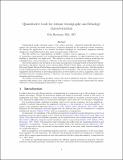Quantitative tools for seismic stratigraphy and lithology characterization
Author(s)
Herrmann, Felix
Downloadherrmann.pdf (7.119Mb)
Other Contributors
Massachusetts Institute of Technology. Earth Resources Laboratory
Metadata
Show full item recordAbstract
Seismological images represent maps of the earth's structure. Apparent bandwidth limitation of seismic data prevents successful estimation of transition sharpness by the multiscale wavelet transform. We discuss the application of two recently developed techniques for (non-linear) singularity analysis designed for bandwidth limited data, such as imaged seismic reflectivity.
The first method is a generalization of Mallat's modulus maxima approach to a method capable of estimating coarse-grained local scaling/sharpness/Hölder regularity of edges/transitions from data residing at essentially one single scale. The method is based on a non-linear criterion predicting the (dis)appearance of local maxima as a function of the data's fractional integrations/differentiations.
The second method is an extension of an atomic decomposition technique based on the greedy Matching Pursuit Algorithm. Instead of the ordinary Spline Wavelet Packet Basis, our method uses multiple Fractional Spline Wavelet Packet Bases, especially designed for seismic reflectivity data. The first method excels in pinpointing the location of the singularities (the stratigraphy). The second method improves the singularity characterization by providing information on the transition's location, magnitude, scale, order and direction (anti-/causal/symmetric). Moreover, the atomic decomposition entails data compression, denoising and deconvolution.
The output of both methods produces a map of the earth's singularity structure. These maps can be overlayed with seismic data, thus providing us with a means to more precisely characterize the seismic reflectivity's litho-stratigraphical information content.
Date issued
2001Publisher
Massachusetts Institute of Technology. Earth Resources Laboratory
Series/Report no.
Earth Resources Laboratory Industry Consortia Annual Report;2001-02